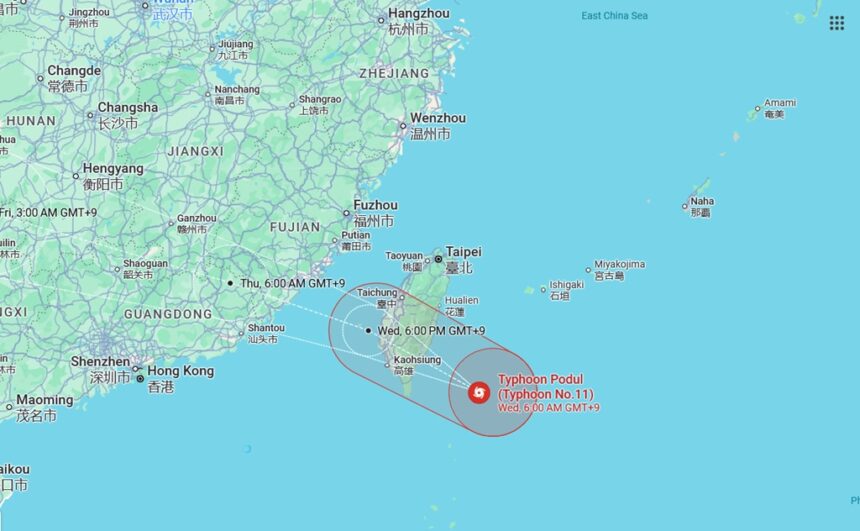TAIPEI – Typhoon Podul is closing in on Taiwan’s southeast coast, carrying the threat of heavy winds and rain has led to large-scale evacuations and put the country on high alert.
The Central Weather Administration (CWA) issued both land and sea warnings on Tuesday, 13 August, as the storm picked up speed, reaching sustained winds of 126 kph and gusts peaking at 162 kph.
With Typhoon Podul expected to make landfall near Taitung or Hualien by midday Wednesday, emergency teams are working quickly to lessen the risks. Many locals are reminded of the destruction caused by earlier typhoons that left lasting scars across the island.
Early Wednesday morning, Podul’s centre was about 500 kilometres east-southeast of Taitung, moving at 25 kph towards the west-northwest. The CWA widened land warnings to cover 10 regions, stretching from Changhua south, and including Nantou, Hualien, and Taitung.
Meteorologist Wu Der-romg, writing for National Central University, pointed out a slight shift south in Podul’s path, now placing the chance of a direct hit at over 80 percent. Wu cautioned that Podul would likely keep its current strength until reaching land, and suggested everyone stay updated with the latest news.
Taiwan Takes Major Precautions
Forecasts predict southern mountain regions could see up to 600 mm of rainfall, and wave heights could top 6 meters along the east coast. The typhoon’s outer bands are set to sweep over Orchid Island and Green Island early on, with Taitung likely feeling the strongest impact around noon.
Typhoon Podul should move off near Tainan by evening, passing Penghu and Kinmen before heading for southern China. The CWA expects to lift warnings by Thursday, although many disruptions are likely before then.
Authorities have rolled out major precautions. In Hualien, nearly 700 residents are leaving areas at risk of landslides and flooding tied to a natural dam created by an earlier storm. Chu Chung-jui of the National Science and Technology Center for Disaster Reduction advised those downstream to follow evacuation orders immediately.
In the south, where communities are still cleaning up after July’s record-breaking typhoon, local governments are moving people out of damaged houses. Kaohsiung, home to 2.7 million people, has already evacuated more than 2,500 people from areas prone to mudslides. Hundreds more have been relocated in Tainan and Pingtung.
Schools and Offices Closed
Podul’s arrival has brought daily routines to a halt across Taiwan. Schools and government offices have closed, and all domestic flights are grounded. Taiwan Railways Administration closed several eastern lines, and ports have shut, causing supply chain delays.
In Taipei, the focus has shifted from recent hot weather warnings to storm prep, as residents buy up basic goods such as instant noodles and bottled water.
The approach of Podul is bringing back memories of previous typhoons that put Taiwan’s disaster readiness to the test. Last October, Typhoon Krathon surprised many when it struck Kaohsiung on the west coast, leading to two deaths and 70 injuries.
That storm unleashed 128 cm of rain in Taitung and 43 cm in Kaohsiung, causing landslides and severe flooding. More than 6,000 people had to evacuate, and Kaohsiung’s airport shut down completely. Mayor Chen Chi-mai compared Krathon’s force to Typhoon Thelma’s in 1977, which took 37 lives.
Going back further, Typhoon Morakot in 2009 stands out for its scale. It killed over 600 people and caused billions in damages, with entire villages in southern Taiwan lost to floodwaters. Typhoon Dujuan in 2015 also left its mark, knocking out power to over 500,000 homes on the east coast. These past events highlight the dangers Podul could bring, especially in mountainous areas where landslides and flash flooding are a constant threat.
Typhoon Podul Winds
Online, people are sharing both worries and plans. @tvbsworldtaiwan posted about “level 12 winds” and dangerous waves along the east coast, urging people to secure their homes.
Weather trackers like @JointCyclone noted Typhoon Podul’s 100 mph winds and low pressure, expecting big downpours, strong winds, and flooding near the shore. Meteorologists, including @Windycom, are warning of gusts over 150 kph and up to 300 mm of rain in some areas, which could lead to flash floods.
Both businesses and families are making preparations. MitKat Advisory Services gave Typhoon Podul a risk score of 4 out of 5, pointing to likely transport and utility problems as well as interruptions in supply chains.
Many companies have put emergency plans in place, securing property and setting up remote work. Residents in flood zones are stacking sandbags, and coastal communities are getting ready for possible seawater flooding.
As Podul draws closer, Taiwan’s experience handling natural disasters stands out. From Morakot to Krathon, the country has improved response efforts, stationing almost 40,000 troops and strengthening evacuation plans.
Even with all these measures, the quick changes in typhoon strength and Taiwan’s tricky terrain keep officials alert. A CWA spokesperson stressed the need not to underestimate Podul, given its rapid growth and the island’s geography.
By Thursday, as Typhoon Podul moves toward China’s Fujian Province, the task of counting the cost will begin. For now, Taiwan is relying on old lessons and new readiness as it faces another powerful storm.














